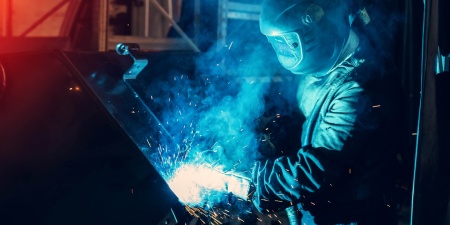By Kelly Bladow
From the driver’s seat to the dock, and whether you’re a gas producer, hardgoods retailer or product manufacturer, there’s no getting away from the necessity of putting safety first in all aspects of welding supplies and gases distribution industry operations.
If you haven’t already established a complete safety program within your company, you may feel that it’s a daunting thing to do. I’m happy to say that putting such a program in place is fairly simple – at least in obtaining the materials for it and in what’s involved in implementation. The trick to getting a safety program to “take” in your company is keeping the safety practices and procedures you introduce updated, consistent and in use on a routine basis.
Successfully cultivating and continuing a safety-first and safety-always mindset is extremely important in our industry for owners, managers and individual employees. When you do the right things and repeat them consistently and frequently, thinking and acting with a “safety-first” mantra in time becomes the automatic way to operate.
I can say that because I’ve begun and grown a comprehensive safety program for my employer, Oxarc. It covers our headquarters, our main fill plant in Pasco, Wash., 12 other Washington state branches, five stores in Idaho and another five in Oregon. I also can tell you something else from that experience: It took a while, it didn’t come automatically, and it happened as a progression over quite a few years. Now, though, as I walk through our facilities, I’ve got an innate safety radar.
What makes me qualified to believe I can advise you on how to implement a safety mindset and program at your place of business? I’ve always been on the operations side of this industry. I started with Oxarc in 1979 and I’ve worked in varied capacities. I started as a filler then worked as a truck driver and later, in cylinder maintenance. At one time, it seemed that work was about quantity over safety. Now, it’s safety over quantity. In addition, no one can forgo quality for safety. They go hand-in-hand. If you do things safely, you’ll do a quality job.
For me, the safety part of the work simply became part of my daily work life. As I progressed in my career, I was able to start training our workforce toward the highest safety goals. Now, as regional operations manager for Oxarc, the big issue I face in implementing a company-wide safety program is promoting a safety culture among the workforce – getting everyone to think with a safety-first mindset.
For Oxarc, safety is the priority at all of our stores, for all of our drivers and in all of our operations. I wanted to offer my experiences so that if you’re thinking about your own program, these thoughts may help you get it up and running.
First: Walk the Walk
The first thing your company needs to do to promote a culture of safety is to walk the walk and talk the talk – and that starts with leadership. At our company, leadership continually promotes the safety culture.
Your leadership must do that visibly. In a safety culture where leaders are walking the walk and talking the talk, if they come out on the floor, they must be wearing safety glasses and hearing protection. Embedding safety into your culture starts at the top, and the leadership’s behavior sets the example. It has to start with leadership; it has to come from the top down.
Second: Constant Talk
The next step is talking about safety issues all you can. At Oxarc, we find ways to talk about safety constantly. We put those topics out in front of the employees as much as possible. I do it personally simply by being seen. I walk through facilities and try to get out on the floor multiple times a day. I do anything I can to make my presence known because when people see me, they’re reminded of the element of safety.
There’s a way to do this without being the 10,000-pound gorilla. It’s done by taking on a purposeful safety mindset. Don’t settle for the ‘I’ve always done it this way,’ or, ‘This is the way I was taught’ ways of thinking. Work processes and practices have to have a basis in safety.
You just need to keep the issues in front of workers and keep reminding them of doing things the safest ways. This habit will evolve and over time, you’ll get employees who will buy into it. Once the employee buys in, that employee also supports a wider safety culture. Then, employees thinking that way will start policing themselves and their co-workers. They’ll remind people about wearing safety glasses, putting on hearing protection, or suggesting a safer way to do something.
We also continually talk about safety in a variety of situations. We talk about it if we learn of an incident in the industry or if one of our locations has a near-miss. We discuss the root causes, what happened and why that happened, and what can be done to prevent it from happening again.
Our company puts an emphasis on the goal of all of us going home from work at night in the same shape we showed up in that morning – maybe a little tired, a little sore, but not broken. It comes down to this basic consideration: We’ve all got jobs to do and we need to produce a quality product. At the end of the day, we all want to go home to our families with our health and safety intact.
The safety issue is certainly about worker safety and preserving the human resources of a company. However, there’s also a cost consideration. Because safety goes to the heart of operations, it’s also a profitability issue. Every corporation has worker’s compensation costs. And any company that has a lot of small, minor injuries also has major expenses associated with that, and they’re the kind of expenses that quickly eat profits.
GAWDA Resources
The benefit for GAWDA members who want to implement safety programs is that there are numerous resources within the GAWDA organization to tap. Association safety consultant Mike Dodd is available to help you anytime. Also GAWDA members benefit by being able to obtain the CGA pamphlets for free. They can obtain these simply by providing a copy of their OSHA 300 log at the beginning of each calendar year. Mike Dodd can provide materials and best-practices information, plus customizable templates for creating your own company materials. The GAWDA website has numerous safety bulletins and other forms of information. GAWDA Safety Committee members are additional resources.
Get Employees Involved
If you’re undertaking a new program, make sure to get your employees involved from the start. You can talk to them about what issues and best practices should be included. Let them help put your program together. It’s typically the people doing the hands-on work who have the best way of getting things done. Enlist their aid in developing your program and give them an ownership stake in it.
The more your employees can be involved and take responsibility for helping develop the program, the more likely it is to succeed. When employees are involved and are part of making something happen, they tend to buy into it. Once they buy in, they’ll take ownership and responsibility and your program will grow legs of its own and take off.
Then, you just have to provide the ongoing vigilance and refreshing of the program, keeping things up to date and top of mind. Keep the program out front and visible. Ensure that it gets talked about and encourage everyone to help the safety culture take hold.
You just have to remember that this is a process. It doesn’t happen overnight; it takes a long time. If you make it part of your daily life at work, it soon kicks in. Before you know it, you’re thinking, working, and living “safety first.” You might even find it soon becomes part of your daily routine at home, just like it is at work.
Good luck! And let me or other members of the Safety Committee know if we can be of assistance.
Kelly Bladow is a GAWDA vice president who, for many years previously, served on the association’s Safety Committee. He is the regional operations manager for Oxarc, Inc., where since 2002, his full-time focus has been dedicated to company-wide operational safety. He is based in the Pasco, Wash., Oxarc facility, but works across all 22 locations in Washington, Oregon and Idaho. He can be reached at: 509-547-2494 or [email protected].








